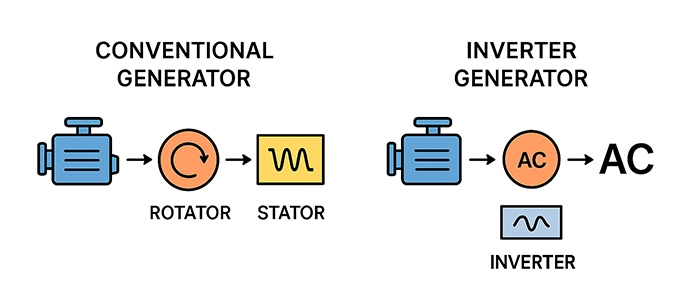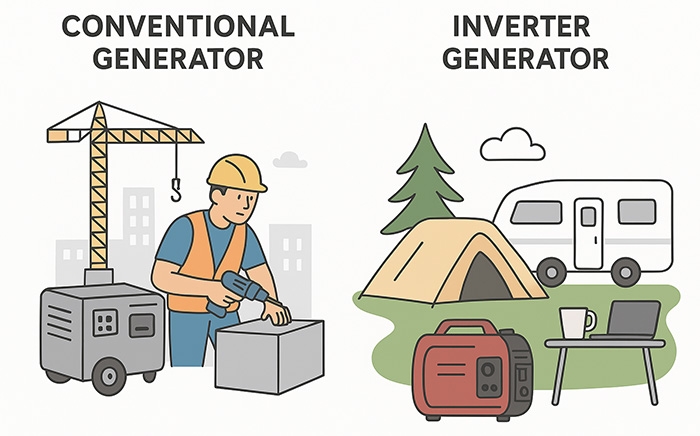In today’s energy usage scenarios — from outdoor camping to construction sites to home emergency backup power — generators have become nearly indispensable. The two most common types on the market are conventional generators (often referred to as traditional AC generators) and inverter generators. Many users get confused when choosing between the two: What exactly is the difference? Which one better fits your needs?
This article from Inverter Store will analyze the differences between inverter generators and conventional generators from multiple perspectives, including working principle, output characteristics, application scenarios, and user experience, to help you make a more informed decision.
Differences in Working Principle
Conventional Generator: Power Quality Depends on Engine Speed
Most conventional generators use synchronous or asynchronous AC generation. The basic logic is: the engine drives the rotor to rotate, inducing AC power in the stator windings. In this process, the frequency of the AC output is closely tied to engine speed. For example, in a 50Hz grid environment, the engine must maintain a stable speed of 3000 RPM or 1500 RPM. However, because there are no extra regulation or correction stages, the voltage and frequency of a conventional generator will fluctuate noticeably with load changes and variations in engine speed. In short, the power quality of a traditional generator largely depends on the stability of its mechanical speed.
Inverter Generator: Multi-Stage Processing Ensures Stable Output
An inverter generator is an upgraded innovation built on the conventional generator, adding rectification and inversion stages. The workflow is: The engine drives the generator to produce AC power. The AC is converted to DC through a rectifier circuit. The inverter module then converts the DC back into AC with a stable frequency and voltage, outputting a clean sine wave. Although this multi-stage power processing increases the generator’s complexity, it significantly improves the quality and stability of the output electricity, providing users with more reliable power support.

Comparing Power Output Characteristics
Voltage and Frequency Stability
- Conventional Generator: Wide voltage fluctuation range; frequency is affected by engine speed. Sudden load changes may cause voltage drops or surges.
- Inverter Generator: Output is corrected by the inverter. Voltage and frequency remain almost constant with minimal fluctuation, reaching stability comparable to utility power.
Harmonics and Waveform Quality
- Conventional Generator: The output waveform may be distorted, with higher harmonic content, posing potential risks to sensitive electronics such as computers, communication equipment, or medical devices.
- Inverter Generator: The inverter generator usually produces a pure sine wave with total harmonic distortion usually below 3%, making it safe to directly power precision electronics.
Differences in Application Scenarios
Conventional Generator: Suitable for Heavy Loads and Lower Power Quality Demands
- Construction sites: Provide high-power electricity for tools, meeting various power demands during building work.
- Agricultural irrigation: Powers pumps and other equipment to ensure farm water supply.
- Temporary high-power demand: For temporary lighting or machinery operation, conventional generators deliver sufficient output.
Summary: Conventional generators are best for rough loads and environments where power quality is less critical, supporting large-scale, high-intensity electricity needs.
Inverter Generator: Suitable Where Power Quality and User Experience Matter
- Home emergency backup: During outages, it keeps refrigerators, TVs, and routers running smoothly for household convenience.
- Outdoor camping or RV trips: Power induction cookers, coffee makers, laptops, and other sensitive devices make outdoor life more comfortable and convenient.
- Medical, communication, or laboratory use: These scenarios demand extremely high power quality. Inverter generators deliver the required stability to ensure equipment runs properly and data remains accurate.
Summary: Inverter generators emphasize power quality and user comfort, are typically designed for small to medium loads, and are ideal for users who demand stable, clean electricity.

Power and Size Comparison
- Conventional Generator: Wide power range — from a few kilowatts to hundreds of kilowatts — able to meet long-term, high-load operation. However, the simple structure (without complex electronic modules) means the size and weight are usually large, making transport and installation inconvenient. They also generate significant noise, which can affect the surrounding environment.
- Inverter Generator: Typically ranges from 1kW to 6kW, targeting portable and mid-sized power needs. Compact and lightweight, some can even be carried with one hand. Ideal for mobile use — from camping to RV travel — inverter generators provide portable electricity wherever needed.
Fuel Efficiency and Noise Levels
Fuel Efficiency
- Conventional Generator: Engine speed must stay locked to frequency (e.g., 3000 RPM for 50Hz). Even under light load, the engine runs at high speed, leading to higher fuel consumption.
- Inverter Generator: Uses variable speed control, adjusting engine RPM based on actual load. At low load, the engine slows down, reducing fuel use significantly.
Noise Levels
- Conventional Generator: Noise typically ranges from 75–95 dB, close to construction machinery levels.
- Inverter Generator: Thanks to noise-reduction design and lower RPM operation, noise is generally 50–65 dB, about the volume of normal conversation — much better for residential areas or camping environments.
User Experience and Convenience
- Conventional Generator: Usually started by manual recoil, which may be inconvenient for some users. Heavyweight also makes it harder to move. During operation, noise and emissions are higher, impacting both the environment and health.
- Inverter Generator: Often supports electric start or one-button start for greater ease. Many models include DC outlets, USB ports, and even smartphone app connectivity for remote control and monitoring. These smart features make inverter generators feel closer to modern intelligent devices, offering a more convenient and comfortable user experience.
Conclusion
In summary, inverter generators and conventional generators each have their own strengths and weaknesses. When buying, you should consider your actual needs, budget, and usage scenarios to choose the generator that best fits you.
Conventional generators are rugged, powerful, and cost-effective for heavy-duty use, while inverter generators deliver quiet, efficient, and high-quality electricity for sensitive equipment and portable scenarios.
We hope this guide helps you make a wise choice from the many options available, ensuring reliable power for both your life and your work. If you have any needs, you can also contact us.
